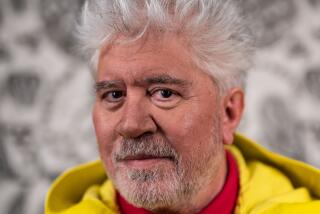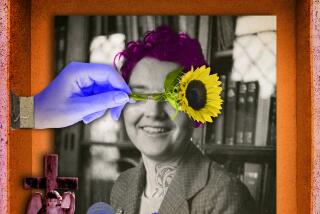The Richest Man in Spain : THE CITY OF MARVELS <i> by Eduardo Mendoza; translated by Bernard Molloy (Harcourt Brace Jovanovich: $19.95; 432 pp.; 0-15-118040-7) </i>
- Share via
As the Catalonians see it, it’s no accident that their capital city, Barcelona, will be hosting the Summer Olympics in 1992. Historically the most enterprising and cosmopolitan corner of Spain, Catalonia took the Republican side in the Spanish Civil War and paid the price in brutal reprisals and decades of political and cultural repression. Now, a dozen years after the death of Franco, Catalonia is at the forefront of the resurgence of regional identity in Spain, and the verve of its revival has been captured in a novel by Eduardo Mendoza called “The City of Marvels.” Though historical in subject matter, this story of Catalonian enterprise and Barcelonan ambition is thoroughly contemporary in spirit.
In 1886, as Barcelona frantically prepares for its first World’s Fair, we meet the novel’s central character, Onofre Bouvila, who, unable to find any better job, is being paid by anarchists to distribute seditious literature. With chilly purposefulness, Onofre moves from selling revolution to selling hair-restorer, then on to pilfering from Fair exhibits and enforcing for organized crime, aided throughout by various comic grotesques--a virile giant, a drag queen, a repulsive chambermaid with a cat named Beelzebub. Occasionally, as during a gang war that paralyzes Barcelona for a week, the narrative gathers terrific momentum and almost succeeds in making Onofre sympathetic as he prepares to make his fortune.
Of the actual amassing of this fortune disappointingly little is shown--a few nifty real estate swindles, some hired hits, some passing years, some arms sales in World War I. Onofre doesn’t grow in character so much as simply become amplified. In his capacity as “the richest man in Spain,” he leads a life replete with the whims, the cars, the girls, the airplane rides, the twisted family life, and especially the hunger for still more that we expect from such a phenomenon. It’s all fairly interesting, but when the book ends, with the launching of Barcelona’s second World’s Fair in 1929, what lingers is not the memory of a real Onofre Bouvila but only the spirit of the hard, flamboyant era he represents.
Paralleling this rags-to-riches story is a popular history of Barcelona, beginning with an account of early Barcelonans admiring Hannibal’s elephants--”Just look at those tusks, those ears, that trunk or proboscis, they remarked”--and ending with a foreshadowing of the city’s suffering under Franco. Mendoza digresses and embroiders with supreme confidence. The lives of saints and anarchists are deftly woven in, and Mata Hari is ushered through the book to explain why “Quo Vadis,” the world’s first feature-length movie, never made it to Spain. Just as often, though, for example in dull cameo appearances by Lenin and Rasputin, Mendoza’s touch is so light as to make no impression at all. Frequent quotations from period newspapers, intended to cast sidelights on the march of history, seem instead to cast unwelcome light on the author’s research methods. And though modern-day Catalonians may find fascinating his account of Barcelona’s architectural growing pains, the impartial reader working through the 10th dense page of it may be forgiven for asking: Is this book for me?
To the extent that Mendoza tries at all to answer this question and find general truth in specific history, he does it as a cynic, highlighting in every anecdote the ugly, the venal, the ridiculous, the cruel. At his best, he rises to a limpid honesty of vision:
“With the thaw a tribe of Gypsies appeared, walking along the beach. The workers’ wives stood in the doors of their huts to block entry, for it was widely believed that Gypsy women stole infants. This tribe was actually just doing what it could to earn its daily bread by mending pans, clipping dogs, telling fortunes, and making bears dance. The workers, having no pans, no dogs, and no futures, were interested only in seeing the bears dance. And so it was that the Civil Guard had to intervene.”
But even a tone as satisfying as this gets old if it isn’t modulated. And although Mendoza at every turn protects his flanks politically by presenting the masses as an unsentimental and undifferentiated martyr class, the world of the novel remains the world of Onofre Bouvila, devoid of kindness and charity and beauty, devoid of redeeming characters, devoid even of complicated ones. To depict an entire epoch in this way is arrogant if we’re meant to believe the world has improved since then; profoundly diminishing if we’re meant to believe it hasn’t. It’s true that after two millennia of jealous persecution, Barcelona and its chroniclers have earned the right to cynicism and also, having in triumph outlasted yet another dictatorship, the right to a little arrogance. Yet despite its intermittent virtuosity, and despite Bernard Molloy’s able translation, an American reading “The City of Marvels” may well feel like the only foreign guest at a Catalonian all-class reunion.
More to Read
Sign up for our Book Club newsletter
Get the latest news, events and more from the Los Angeles Times Book Club, and help us get L.A. reading and talking.
You may occasionally receive promotional content from the Los Angeles Times.







